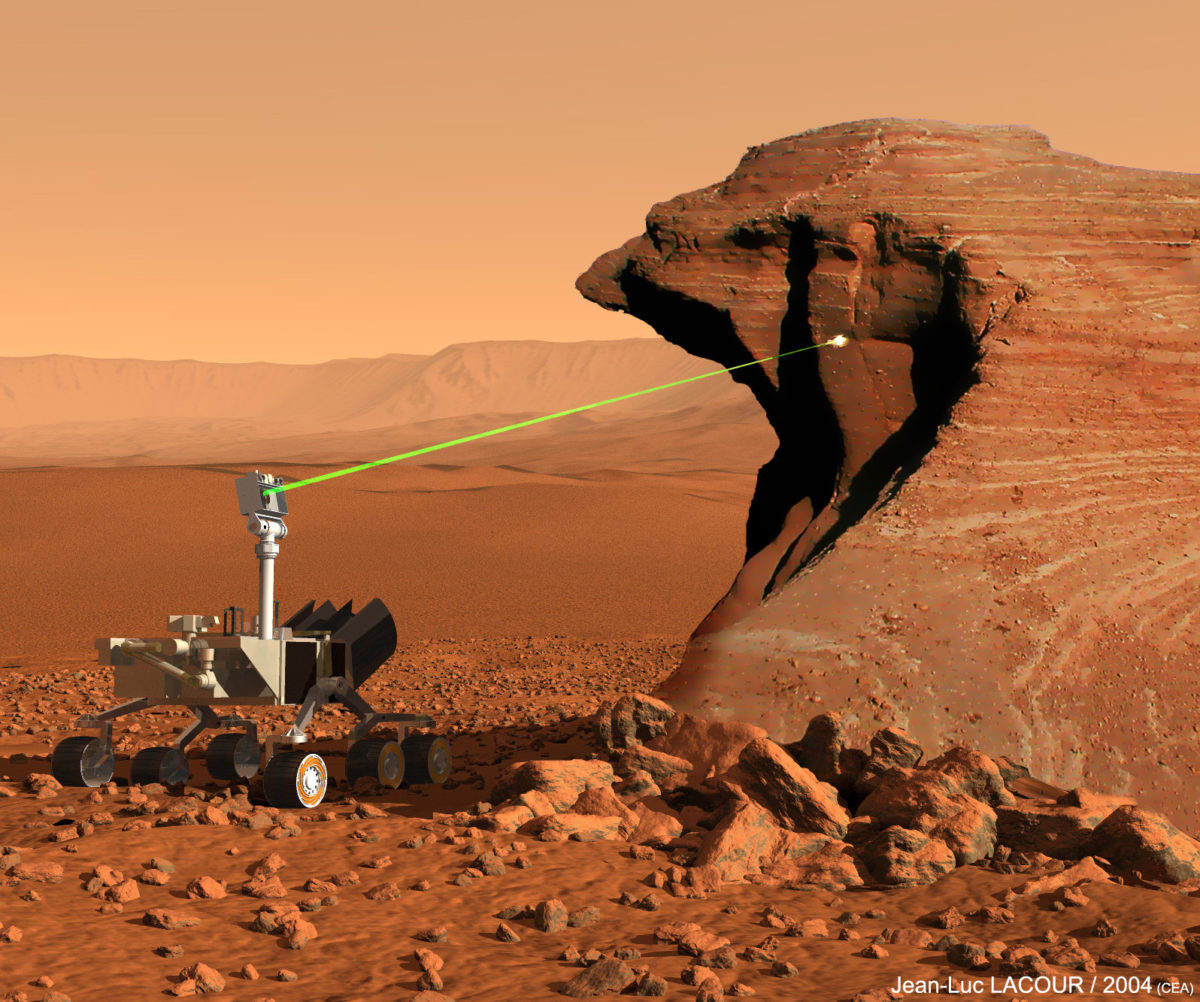Ryan Anderson • May 27, 2011
Zapping Rocks for Science
Laser beams and space exploration are perfect for each other, and not just because all self-respecting starship captains know their way around a blaster. It turns out that zapping rocks with a laser is not only fun, it also can tell you what they're made of!
The technique, called "laser-induced breakdown spectroscopy" or LIBS, involves blasting a target with a concentrated laser pulse which turns a few nanograms of the target into an expanding spark of plasma. Plasma is a state of matter like a gas, but it is so hot that the electrons around the atoms have extra energy and in some cases have broken free from their atom altogether. As the plasma cools, stray electrons are reunited with their atoms and excited electrons shed their excess energy in the form of light. Like a luminous fingerprint, the specific colors of light given off by each element are unique, so by studying the spectrum of the plasma, we can tell what elements are there and therefore what the target was made of.

This image from testing of ChemCam shows a ball of luminous plasma erupting from the surface of an iron pyrite crystal in the sample chamber approximately 3 meters from the instrument. The laser beam itself is invisible.Image: NASA / JPL
This image from testing of ChemCam shows a ball of luminous plasma erupting from the surface of an iron pyrite crystal in the sample chamber approximately 3 meters (10 feet) from the instrument. The laser beam itself is invisible.Of course, we want to do more than just see what elements are there. Ideally, we would like to know how much of each element is there. You might think that this would be simple: if the plasma emits more photons characteristic of silicon, then there is more silicon, right? Well, yes, but unfortunately if you double the amount of silicon, it does not necessarily double the brightness of silicon emissions. All sorts of other factors have an effect: how well does the target absorb the laser's energy? What other elements are in the sample? Does any of the emission get absorbed by the plasma itself before getting to the spectrometer?
To work around these complications, we use so-called "multivariate" techniques. Instead of looking at just the specific wavelengths of light that correspond to each element, these methods consider the full spectrum of a suite of training samples and construct a mathematical model relating the brightness at each wavelength to the abundance of each element. Using the spectrum of an unknown sample and this model, we get a prediction of the unknown sample's composition. This tends to gives more accurate results than just looking at a single wavelength of light, especially if the unknown sample is similar to the samples used to construct the model.
The great advantage of laser induced breakdown spectroscopy is that you don't have to touch the laser's target. For example, the ChemCam instrument on Curiosity will be able to zap and analyze rocks up to 7 meters (23 feet) away. Even better, it takes only seconds to collect dozens of LIBS spectra of a target, and the shockwave from the plasma does a nice job of puffing away any dust on the target's surface. This means that LIBS fills the gap between true remote-sensing instruments like cameras and passive spectrometers and contact instruments which typically require painstaking positioning of the rover and its arm, and a lengthy period of data collection. The compositions derived from LIBS are not quite as accurate as those you might get from the alpha particle x-ray spectrometer at the tip of the rover's arm. But the LIBS observation is essentially instant and can target places where the robotic arm could never reach, such as a sheer cliff face. LIBS is also sensitive to lightweight elements that other instruments can't see, such as hydrogen.
Since LIBS is such a quick, low-power technique that is effective at a distance, it will be a powerful tool allowing Curiosity (and other future rovers) to identify nearby rocks and pick out those that merit further investigation with the rest of the instruments. ChemCam also can take pictures with the same telescope that collects the plasma spectrum, so it can study the detailed texture of rocks and soils from a distance.
Curiosity's ChemCam is the first and best-known LIBS instrument on a planetary mission, but there is a bunch of other missions planning to carry similar lasers. One of the three finalist New Frontiers missions, the Surface and Atmosphere Geochemical Explorer (SAGE) plans to land on the surface of Venus and frantically zap as many rocks as possible before it succumbs to the heat and pressure. SAGE wasn't selected, unfortunately, but it will likely be re-proposed the next time around. Its current design calls for combining LIBS with another laser-based technique called Raman spectroscopy, which give information about the molecular structure of the target. The rapid analysis using the LIBS/Raman instrument will allow the mission to collect a lot more data than if it had to use more traditional techniques.
Another planned laser-toting mission is the joint Indian-Russian Chandrayaan-2 lunar orbiter/rover. One of the two primary science instruments on the rover will be a laser induced breakdown spectrometer. The European Space Agency's troubled ExoMars rover was supposed to carry a combined Raman/LIBS instrument, but budget cuts forced them to leave out the LIBS capabilities. The Canadian and Japanese space agencies have also started looking into LIBS instruments for future missions. There is even ongoing work on a backpack-mounted LIBS instrument for use in the field on Earth, and perhaps eventually in space. Maybe all those science fiction movies were right and spaceship captains of the future really will land with lasers ready -- to analyze the composition of any hostile life forms.


 Explore Worlds
Explore Worlds Find Life
Find Life Defend Earth
Defend Earth


